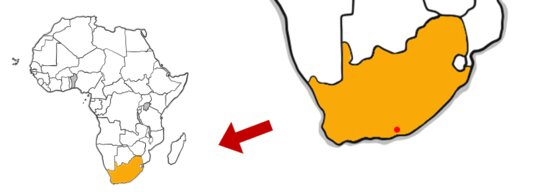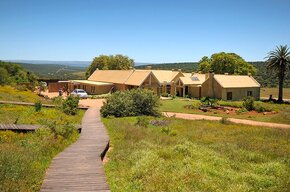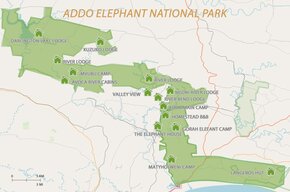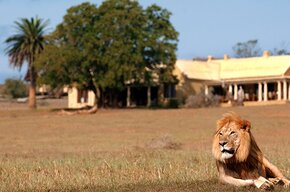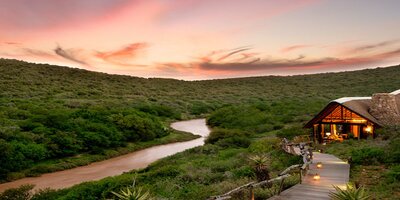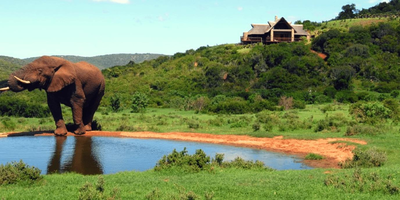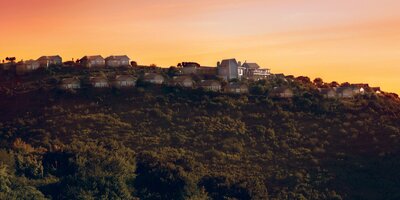Overview
Addo Elephant National Park has become the third largest game reserve in the country after its recent expansion. The South African game reserve is famous among tourist for its large elephant herds that graze on the vegetation and parade in a calm manner. You can witness these marvelous creatures by simply traveling to one of the waterholes, which is a hot spot for elephants. The game reserve is also famous for viewing the Big 5. Visitors can visit Algoa Bay for an opportunity to witness southern right whales and white sharks.Why Go:
- Free from malaria
- Home to the 'Big 7'
- Best elephant watching experience
- Unique and diverse wildlife sanctuary
- Well developed infrastructure and excellent facilities
- Wide choice of lodging options with flexible pricing
Wildlife
The National Park is home to more than 600 elephants and is the primary attraction for visitors. The game reserve is also home to black rhinos, Big Five and more than 400 Cape buffalos. Other species include greater kudu, Burchell’s zebra, Meerkat, and red hartebeest.
More About the WildlifeScenery
Addo game reserve features various vegetation areas that are fynbos (fine-leaved plants), Albany thicket (dense woodland), forest, Indian Ocean coastal belt and Nama Karoo (dry shrubland). The vegetation is the primary source of food for the elephants.
Best Time to Visit
The best time to visit Addo Elephant National Park for people, who avoid crowds, is during the winter, which requires tourists to carry warm clothes, as temperatures can drop to zero degrees. The summer season is usually overcrowded with people and prices increase.
More About the Best Time to VisitWeather & Climate
The summer rainfall is from October to April that often extends to winter months, which are from May to September.
More About the Weather and ClimateWildlife & Animals
The game reserve is renowned for its elephant population along with the big five. Visitors can witness lions roaming the landscape early in the morning. Black rhinos are also present in the region, but due to their shy nature, they tend to stay in their thickets.
Elephant
Abundant
Giraffe
None
Hippo
Rare
Buffalo
Occasional
Zebra
Common
Wildebeest
Common
White Rhino
None
Black Rhino
Rare
Lion
Occasional
Leopard
Rare
Cheetah
None
Hyena
Occasional
Wild Dog
Rare
Wildlife highlights
Some of the more interesting antelope species regularly encountered are greater kudu, red hartebeest and eland. The rare and flightless dung beetle has the right-of-way on the roads and plays an important role in recycling nutrients to stimulate vegetation growth.Best time for wildlife viewing
Game viewing is always in abundance in the game reserve. However, during the dry-summer seasons, you can witness a concentration of animals at the waterholes.Best Time to Visit
- Best Time to GoMay to September
(Dry season) - High SeasonOctober to March
(The park gets crowded)
June - September
Little rain
October - March
The park gets crowded during school holidays
April - September
Excellent time for game viewing
September - April
Warmer nights and mornings
June - August
Cold nights
May to September
- Dry Season – Winter- Wildlife gathers around waterholes as there is little water in the bush
October to April
- Wet Season – Summer- Sunny skies
Weather & Climate
Unlike the summer rainfall pattern covering most of the country, rainfall is relatively evenly distributed throughout the year, but there are two peaks: in February-March and October-November. It can cool down to freezing in mid-winter. The park ranges from the coast to the Zuurberg Mountains, creating a wide range of altitudes. The main park area is at low altitude (under 250m).Climate Chart
- -14-901m/-46-2,956ft© chart & park data: SafariBookings. © climate grid data: WorldClim project. All rights reserved.
Getting There
Addo Elephant National Park is usually accessible via Cape Town International Airport or O.R. Tambo International Airport. For people opting for the self-drive option, they can reach the destination via Garden Route.Airlines and Tickets
To book your International and local flights, it is best to discuss options with our agents. They will be able to secure best tariffs and match it with your safari dates.
Click on Enquire Now for a free consultation.

